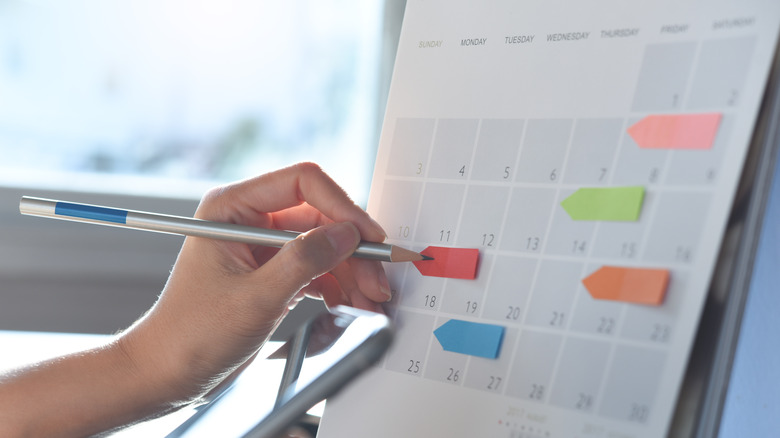What To Know About Cycle Syncing And How It Can Impact Your Life
If you have a menstrual cycle, you've probably noticed that where you are in the cycle significantly affects your energy level, mental clarity, motivation, and productivity. The corporate model of modern life has been modeled off the circadian rhythm. This rhythm, according to the Sleep Foundation, is the natural, hormone-driven 24-hour cycle of sleeping when it's dark outside and being productive during the day. However, people who menstruate are typically more strongly affected by what is known as the infradian rhythm. The infradian rhythm has been referred to by Alisa Vitti, creator of Flo Living and coiner of the term "cycle syncing," as a second biological clock. Basically, it's the 28-day cycle that encompasses the four phases of the menstrual cycle.
Like the moon, bodies that experience menstruation start a fresh new cycle about every 28 days. Each time this cycle completes is another opportunity to understand and utilize your body's follicular phase, ovulation, luteal phase, and menstruation to set up a system that works to your current strengths and weaknesses. This strategy of designing your life around your menstrual cycle is called cycle syncing. Here's what you need to know about each phase and how to use them to your advantage.
Follicular phase and ovulation
The follicular phase is the powerhouse that occurs for about two weeks right after your period ends. This is when the production of the reproductive hormones estrogen and progesterone are both low, as detailed by the Cleveland Clinic. As a result, you'll feel most capable of taking on the world...or just facing your most dreaded tasks like laundry or catching up on phone calls. This is the highest energy phase and a time for planning and new beginnings. If you've been yearning to re-organize your closet, start a new fitness program, or look into a career change, now is the time.
After the follicular phase, according to Clue, estrogen and testosterone rise to prepare for ovulation. During the ovulatory phase, you'll find yourself feeling confident and drawn to connecting with other people. If you're scheduling a networking event, a first date, or a sales meeting, try penciling it in this week. It's also the perfect time to try out a new makeup, hair, or fashion style and absolutely rock it. This is the shortest phase, only lasting three or four days, so take advantage of it.
Luteal phase and menstruation
The luteal phase is the second-longest phase of the menstrual cycle and often the most challenging. If you suffer from premenstrual syndrome (PMS) or premenstrual dysphoric disorder (PMDD), this is the time of the month when your symptoms appear. Nearly three-quarters of women suffer from premenstrual symptoms like fatigue, bloating, and irritability, as reported by the Office on Women's Health. Even if you don't struggle with these extra challenges, prepare for energy levels to drop as progesterone levels peak. This is the time for rest and self-care. Try to limit your work to tasks that are solitary and low-energy like bookkeeping or file maintenance, if possible. Use this time to explore your inner world and nourish yourself physically, mentally, and emotionally.
The last phase of the menstrual cycle is menstruation, also known as your period. When you bleed, your high levels of estrogen and progesterone rapidly drop. According to a study published by the Pakistan Journal of Medical Science, this sudden hormonal change can leave you feeling tired, drained, and groggy, especially if you experience heavy bleeding. However, during this phase, the two hemispheres of the brain experience a period of heightened communication with one another. This allows you to analyze and process the events of the past cycle deeply. Use this clarity to evaluate what worked for you this month and what didn't and carry that knowledge into the next follicular phase where you can shape it into a fully developed plan.


